fuel filler Hyundai Elantra 2013 Owner's Manual
[x] Cancel search | Manufacturer: HYUNDAI, Model Year: 2013, Model line: Elantra, Model: Hyundai Elantra 2013Pages: 383, PDF Size: 8.94 MB
Page 16 of 383
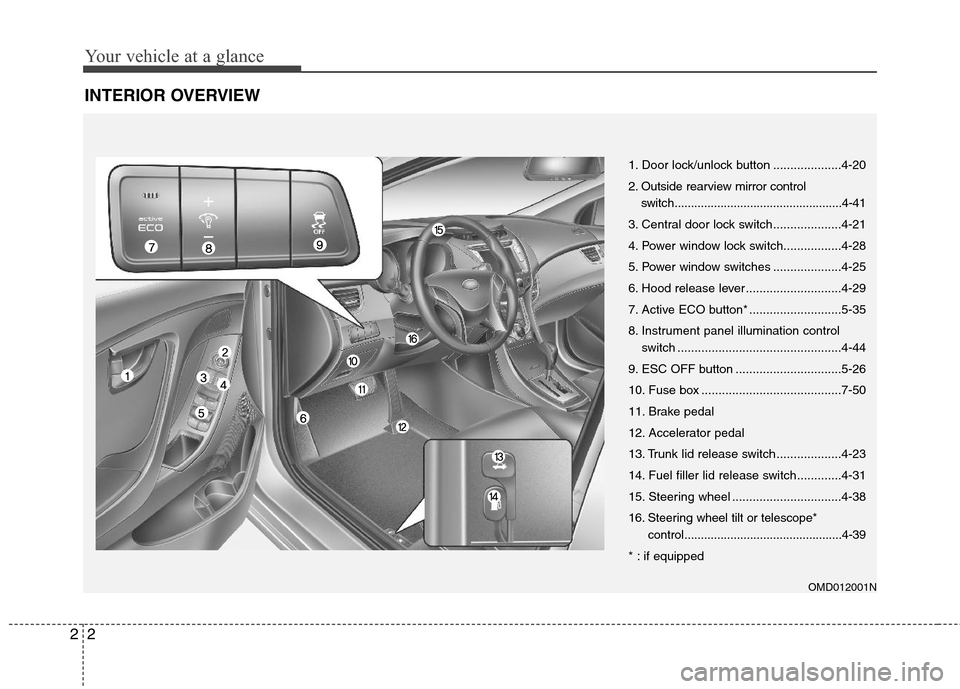
Your vehicle at a glance
2 2
INTERIOR OVERVIEW
OMD012001N
1. Door lock/unlock button ....................4-20
2. Outside rearview mirror control
switch...................................................4-41
3. Central door lock switch....................4-21
4. Power window lock switch.................4-28
5. Power window switches ....................4-25
6. Hood release lever ............................4-29
7. Active ECO button* ...........................5-35
8. Instrument panel illumination control
switch ................................................4-44
9. ESC OFF button ...............................5-26
10. Fuse box .........................................7-50
11. Brake pedal
12. Accelerator pedal
13. Trunk lid release switch ...................4-23
14. Fuel filler lid release switch.............4-31
15. Steering wheel ................................4-38
16. Steering wheel tilt or telescope*
control................................................4-39
* : if equipped
Page 79 of 383
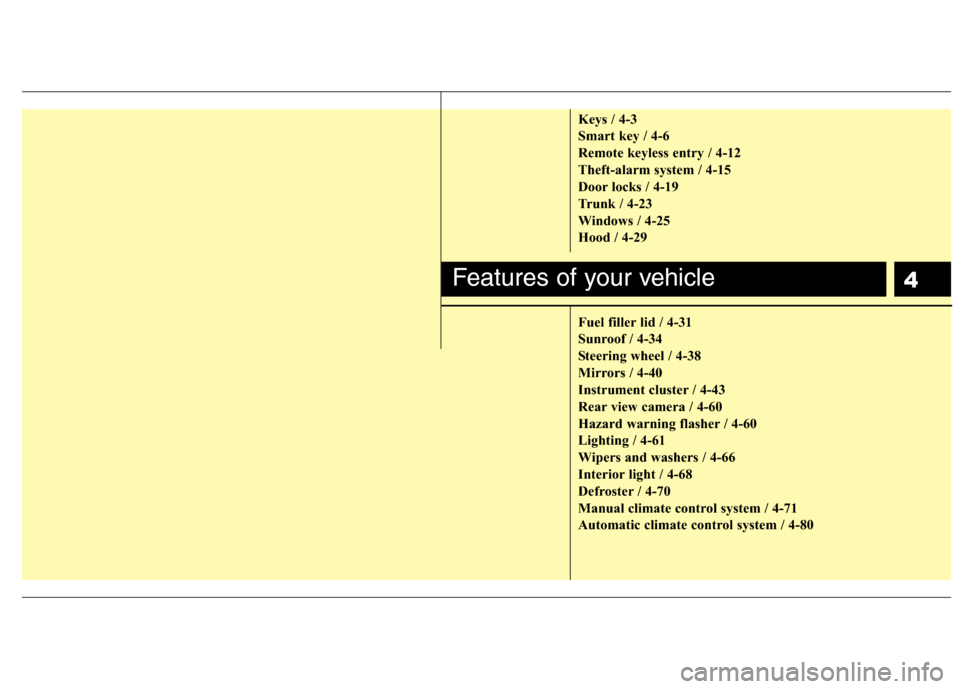
4
Keys / 4-3
Smart key / 4-6
Remote keyless entry / 4-12
Theft-alarm system / 4-15
Door locks / 4-19
Trunk / 4-23
Windows / 4-25
Hood / 4-29
Fuel filler lid / 4-31
Sunroof / 4-34
Steering wheel / 4-38
Mirrors / 4-40
Instrument cluster / 4-43
Rear view camera / 4-60
Hazard warning flasher / 4-60
Lighting / 4-61
Wipers and washers / 4-66
Interior light / 4-68
Defroster / 4-70
Manual climate control system / 4-71
Automatic climate control system / 4-80
Features of your vehicle
Page 109 of 383
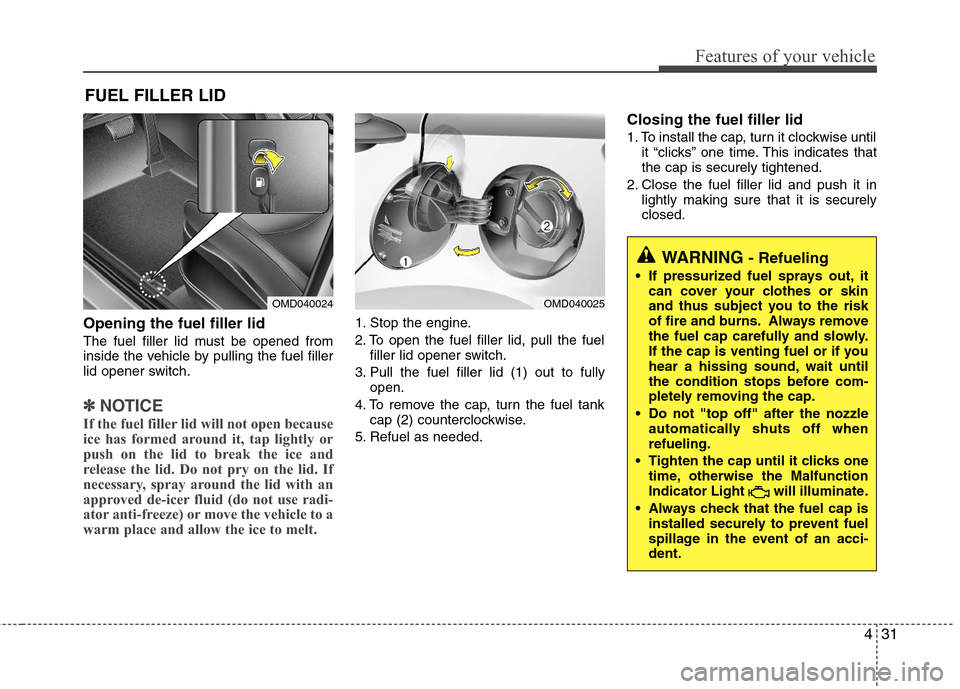
431
Features of your vehicle
Opening the fuel filler lid
The fuel filler lid must be opened from
inside the vehicle by pulling the fuel filler
lid opener switch.
Ō£Į Ō£Į
NOTICE
If the fuel filler lid will not open because
ice has formed around it, tap lightly or
push on the lid to break the ice and
release the lid. Do not pry on the lid. If
necessary, spray around the lid with an
approved de-icer fluid (do not use radi-
ator anti-freeze) or move the vehicle to a
warm place and allow the ice to melt.
1. Stop the engine.
2. To open the fuel filler lid, pull the fuel
filler lid opener switch.
3. Pull the fuel filler lid (1) out to fully
open.
4. To remove the cap, turn the fuel tank
cap (2) counterclockwise.
5. Refuel as needed.
Closing the fuel filler lid
1. To install the cap, turn it clockwise until
it ŌĆ£clicksŌĆØ one time. This indicates that
the cap is securely tightened.
2. Close the fuel filler lid and push it in
lightly making sure that it is securely
closed.
FUEL FILLER LID
OMD040024OMD040025
WARNING - Refueling
If pressurized fuel sprays out, it
can cover your clothes or skin
and thus subject you to the risk
of fire and burns. Always remove
the fuel cap carefully and slowly.
If the cap is venting fuel or if you
hear a hissing sound, wait until
the condition stops before com-
pletely removing the cap.
Do not "top off" after the nozzle
automatically shuts off when
refueling.
Tighten the cap until it clicks one
time, otherwise the Malfunction
Indicator Light will illuminate.
Always check that the fuel cap is
installed securely to prevent fuel
spillage in the event of an acci-
dent.
Page 110 of 383
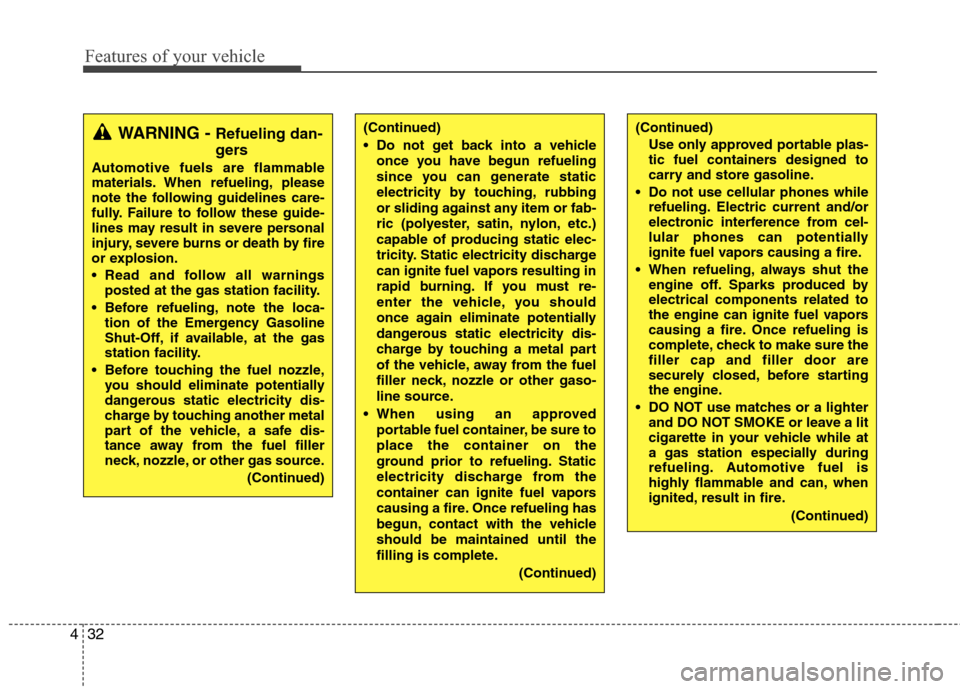
Features of your vehicle
32 4
(Continued)
Use only approved portable plas-
tic fuel containers designed to
carry and store gasoline.
Do not use cellular phones while
refueling. Electric current and/or
electronic interference from cel-
lular phones can potentially
ignite fuel vapors causing a fire.
When refueling, always shut the
engine off. Sparks produced by
electrical components related to
the engine can ignite fuel vapors
causing a fire. Once refueling is
complete, check to make sure the
filler cap and filler door are
securely closed, before starting
the engine.
DO NOT use matches or a lighter
and DO NOT SMOKE or leave a lit
cigarette in your vehicle while at
a gas station especially during
refueling. Automotive fuel is
highly flammable and can, when
ignited, result in fire.
(Continued)(Continued)
Do not get back into a vehicle
once you have begun refueling
since you can generate static
electricity by touching, rubbing
or sliding against any item or fab-
ric (polyester, satin, nylon, etc.)
capable of producing static elec-
tricity. Static electricity discharge
can ignite fuel vapors resulting in
rapid burning. If you must re-
enter the vehicle, you should
once again eliminate potentially
dangerous static electricity dis-
charge by touching a metal part
of the vehicle, away from the fuel
filler neck, nozzle or other gaso-
line source.
When using an approved
portable fuel container, be sure to
place the container on the
ground prior to refueling. Static
electricity discharge from the
container can ignite fuel vapors
causing a fire. Once refueling has
begun, contact with the vehicle
should be maintained until the
filling is complete.
(Continued)WARNING - Refueling dan-
gers
Automotive fuels are flammable
materials. When refueling, please
note the following guidelines care-
fully. Failure to follow these guide-
lines may result in severe personal
injury, severe burns or death by fire
or explosion.
Read and follow all warnings
posted at the gas station facility.
Before refueling, note the loca-
tion of the Emergency Gasoline
Shut-Off, if available, at the gas
station facility.
Before touching the fuel nozzle,
you should eliminate potentially
dangerous static electricity dis-
charge by touching another metal
part of the vehicle, a safe dis-
tance away from the fuel filler
neck, nozzle, or other gas source.
(Continued)
Page 111 of 383
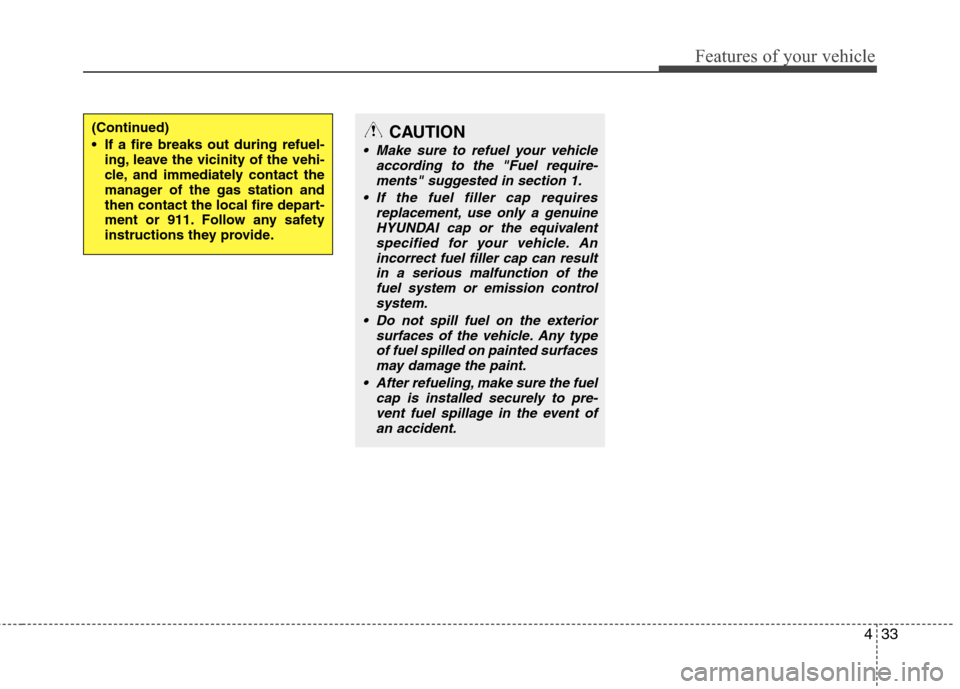
433
Features of your vehicle
(Continued)
If a fire breaks out during refuel-
ing, leave the vicinity of the vehi-
cle, and immediately contact the
manager of the gas station and
then contact the local fire depart-
ment or 911. Follow any safety
instructions they provide.CAUTION
Make sure to refuel your vehicle
according to the "Fuel require-
ments" suggested in section 1.
If the fuel filler cap requires
replacement, use only a genuine
HYUNDAI cap or the equivalent
specified for your vehicle. An
incorrect fuel filler cap can result
in a serious malfunction of the
fuel system or emission control
system.
Do not spill fuel on the exterior
surfaces of the vehicle. Any type
of fuel spilled on painted surfaces
may damage the paint.
After refueling, make sure the fuel
cap is installed securely to pre-
vent fuel spillage in the event of
an accident.
Page 296 of 383
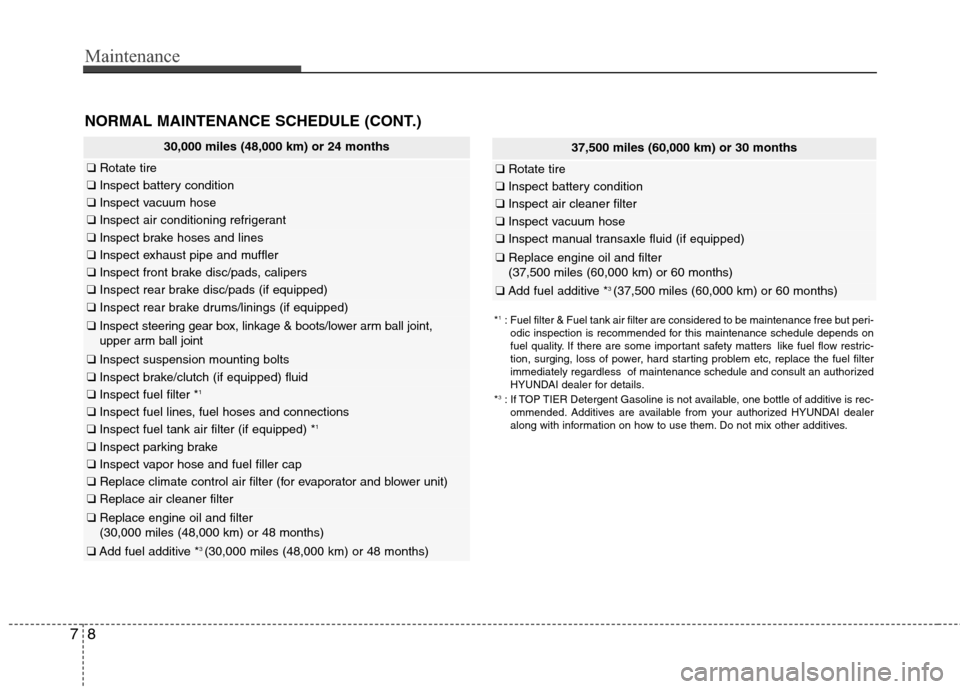
Maintenance
8 7
NORMAL MAINTENANCE SCHEDULE (CONT.)
37,500 miles (60,000 km) or 30 months
ŌØæRotate tire
ŌØæInspect battery condition
ŌØæInspect air cleaner filter
ŌØæInspect vacuum hose
ŌØæInspect manual transaxle fluid (if equipped)
ŌØæReplace engine oil and filter
(37,500 miles (60,000 km) or 60 months)
ŌØæAdd fuel additive *3 (37,500 miles (60,000 km) or 60 months)
*1: Fuel filter & Fuel tank air filter are considered to be maintenance free but peri-
odic inspection is recommended for this maintenance schedule depends on
fuel quality. If there are some important safety matters like fuel flow restric-
tion, surging, loss of power, hard starting problem etc, replace the fuel filter
immediately regardless of maintenance schedule and consult an authorized
HYUNDAI dealer for details.
*
3: If TOP TIER Detergent Gasoline is not available, one bottle of additive is rec-
ommended. Additives are available from your authorized HYUNDAI dealer
along with information on how to use them. Do not mix other additives.
30,000 miles (48,000 km) or 24 months
ŌØæRotate tire
ŌØæInspect battery condition
ŌØæInspect vacuum hose
ŌØæInspect air conditioning refrigerant
ŌØæInspect brake hoses and lines
ŌØæInspect exhaust pipe and muffler
ŌØæInspect front brake disc/pads, calipers
ŌØæInspect rear brake disc/pads (if equipped)
ŌØæInspect rear brake drums/linings (if equipped)
ŌØæInspect steering gear box, linkage & boots/lower arm ball joint,
upper arm ball joint
ŌØæInspect suspension mounting bolts
ŌØæInspect brake/clutch (if equipped) fluid
ŌØæInspect fuel filter *1
ŌØæInspect fuel lines, fuel hoses and connections
ŌØæInspect fuel tank air filter (if equipped) *1
ŌØæInspect parking brake
ŌØæInspect vapor hose and fuel filler cap
ŌØæReplace climate control air filter (for evaporator and blower unit)
ŌØæReplace air cleaner filter
ŌØæReplace engine oil and filter
(30,000 miles (48,000 km) or 48 months)
ŌØæAdd fuel additive *3 (30,000 miles (48,000 km) or 48 months)
Page 298 of 383
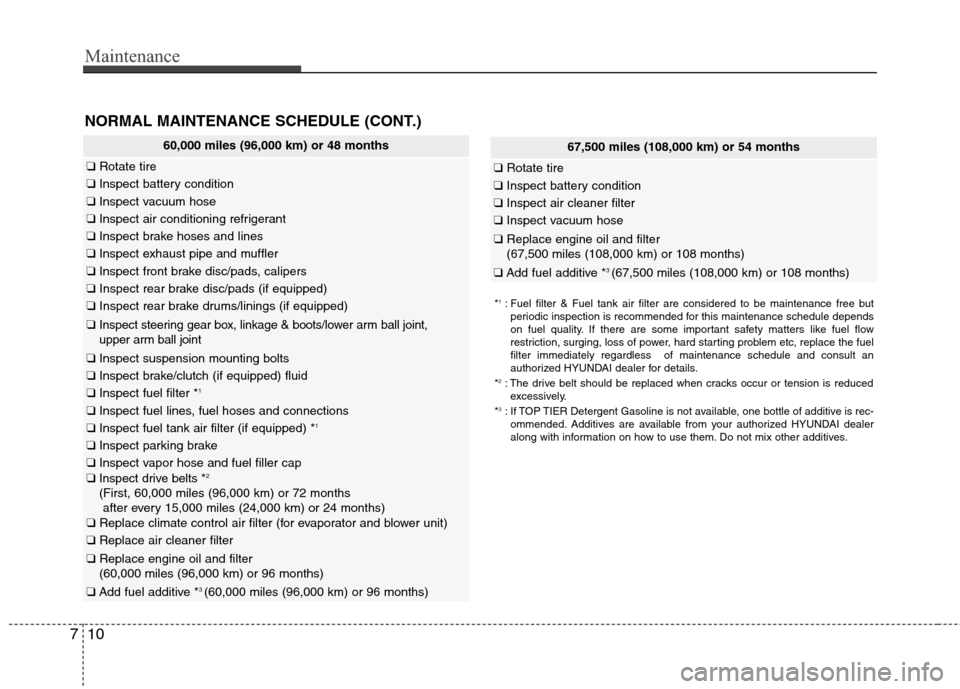
Maintenance
10 7
60,000 miles (96,000 km) or 48 months
ŌØæRotate tire
ŌØæInspect battery condition
ŌØæInspect vacuum hose
ŌØæInspect air conditioning refrigerant
ŌØæInspect brake hoses and lines
ŌØæInspect exhaust pipe and muffler
ŌØæInspect front brake disc/pads, calipers
ŌØæInspect rear brake disc/pads (if equipped)
ŌØæInspect rear brake drums/linings (if equipped)
ŌØæInspect steering gear box, linkage & boots/lower arm ball joint,
upper arm ball joint
ŌØæInspect suspension mounting bolts
ŌØæInspect brake/clutch (if equipped) fluid
ŌØæInspect fuel filter *1
ŌØæInspect fuel lines, fuel hoses and connections
ŌØæInspect fuel tank air filter (if equipped) *1
ŌØæInspect parking brake
ŌØæInspect vapor hose and fuel filler capŌØæInspect drive belts *2
(First, 60,000 miles (96,000 km) or 72 months
after every 15,000 miles (24,000 km) or 24 months)
ŌØæReplace climate control air filter (for evaporator and blower unit)
ŌØæReplace air cleaner filter
ŌØæReplace engine oil and filter
(60,000 miles (96,000 km) or 96 months)
ŌØæAdd fuel additive *3 (60,000 miles (96,000 km) or 96 months)
67,500 miles (108,000 km) or 54 months
ŌØæRotate tire
ŌØæInspect battery condition
ŌØæInspect air cleaner filter
ŌØæInspect vacuum hose
ŌØæReplace engine oil and filter
(67,500 miles (108,000 km) or 108 months)
ŌØæAdd fuel additive *3 (67,500 miles (108,000 km) or 108 months)
NORMAL MAINTENANCE SCHEDULE (CONT.)
*1: Fuel filter & Fuel tank air filter are considered to be maintenance free but
periodic inspection is recommended for this maintenance schedule depends
on fuel quality. If there are some important safety matters like fuel flow
restriction, surging, loss of power, hard starting problem etc, replace the fuel
filter immediately regardless of maintenance schedule and consult an
authorized HYUNDAI dealer for details.
*
2: The drive belt should be replaced when cracks occur or tension is reduced
excessively.
*
3: If TOP TIER Detergent Gasoline is not available, one bottle of additive is rec-
ommended. Additives are available from your authorized HYUNDAI dealer
along with information on how to use them. Do not mix other additives.
Page 300 of 383
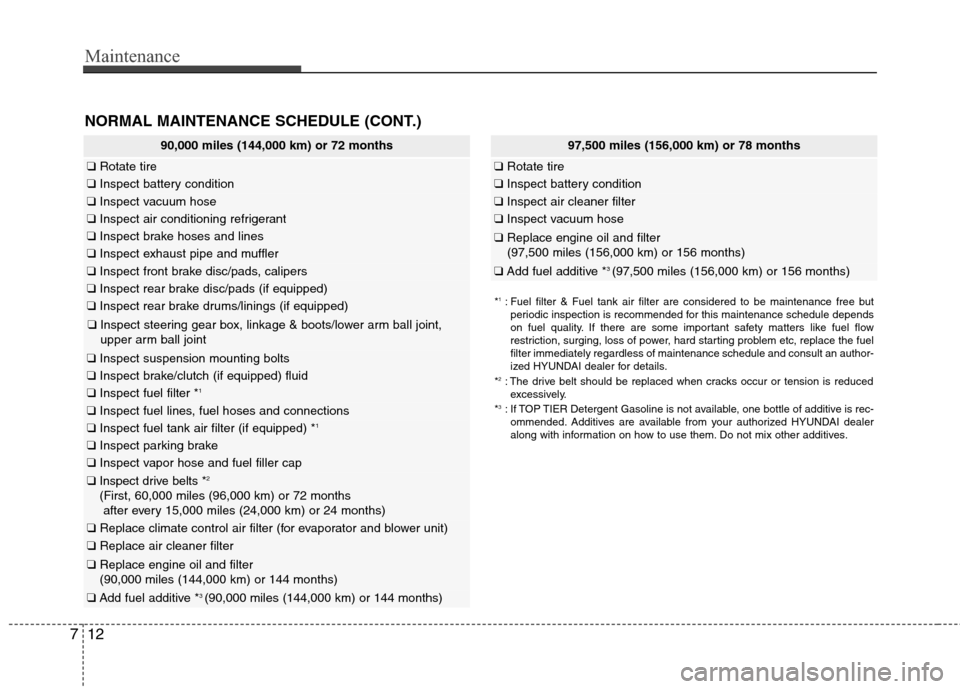
Maintenance
12 7
NORMAL MAINTENANCE SCHEDULE (CONT.)
97,500 miles (156,000 km) or 78 months
ŌØæRotate tire
ŌØæInspect battery condition
ŌØæInspect air cleaner filter
ŌØæInspect vacuum hose
ŌØæReplace engine oil and filter
(97,500 miles (156,000 km) or 156 months)
ŌØæAdd fuel additive *3 (97,500 miles (156,000 km) or 156 months)
90,000 miles (144,000 km) or 72 months
ŌØæRotate tire
ŌØæInspect battery condition
ŌØæInspect vacuum hose
ŌØæInspect air conditioning refrigerant
ŌØæInspect brake hoses and lines
ŌØæInspect exhaust pipe and muffler
ŌØæInspect front brake disc/pads, calipers
ŌØæInspect rear brake disc/pads (if equipped)
ŌØæInspect rear brake drums/linings (if equipped)
ŌØæInspect steering gear box, linkage & boots/lower arm ball joint,
upper arm ball joint
ŌØæInspect suspension mounting bolts
ŌØæInspect brake/clutch (if equipped) fluid
ŌØæInspect fuel filter *1
ŌØæInspect fuel lines, fuel hoses and connections
ŌØæInspect fuel tank air filter (if equipped) *1
ŌØæInspect parking brake
ŌØæInspect vapor hose and fuel filler cap
ŌØæInspect drive belts *2
(First, 60,000 miles (96,000 km) or 72 months
after every 15,000 miles (24,000 km) or 24 months)
ŌØæReplace climate control air filter (for evaporator and blower unit)
ŌØæReplace air cleaner filter
ŌØæReplace engine oil and filter
(90,000 miles (144,000 km) or 144 months)
ŌØæAdd fuel additive *3 (90,000 miles (144,000 km) or 144 months)
*1: Fuel filter & Fuel tank air filter are considered to be maintenance free but
periodic inspection is recommended for this maintenance schedule depends
on fuel quality. If there are some important safety matters like fuel flow
restriction, surging, loss of power, hard starting problem etc, replace the fuel
filter immediately regardless of maintenance schedule and consult an author-
ized HYUNDAI dealer for details.
*
2: The drive belt should be replaced when cracks occur or tension is reduced
excessively.
*
3: If TOP TIER Detergent Gasoline is not available, one bottle of additive is rec-
ommended. Additives are available from your authorized HYUNDAI dealer
along with information on how to use them. Do not mix other additives.
Page 302 of 383
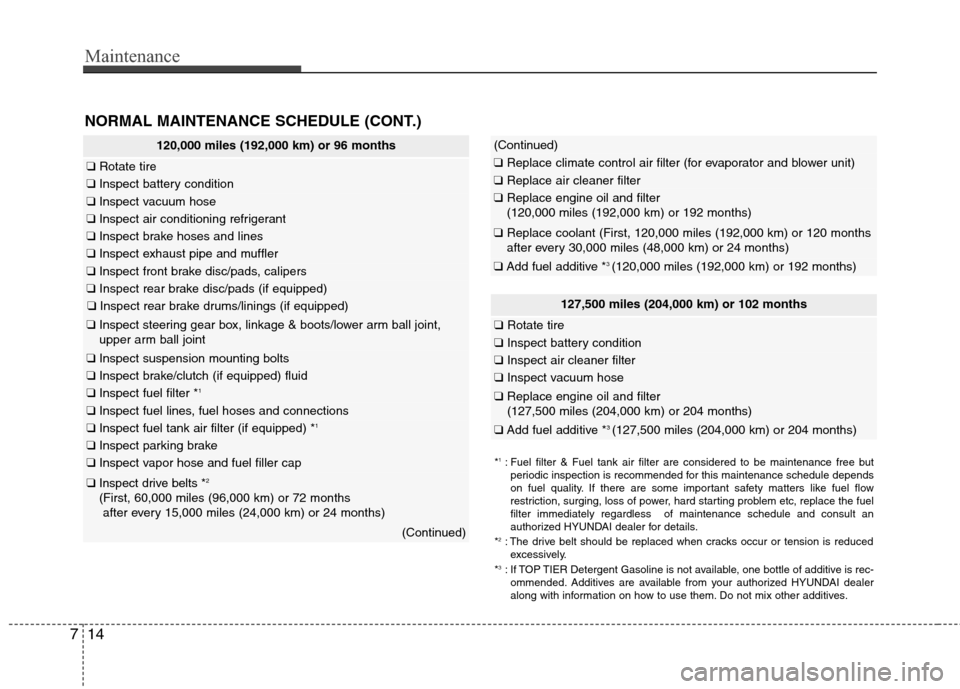
Maintenance
14 7
NORMAL MAINTENANCE SCHEDULE (CONT.)
120,000 miles (192,000 km) or 96 months
ŌØæRotate tire
ŌØæInspect battery condition
ŌØæInspect vacuum hose
ŌØæInspect air conditioning refrigerant
ŌØæInspect brake hoses and lines
ŌØæInspect exhaust pipe and muffler
ŌØæInspect front brake disc/pads, calipers
ŌØæInspect rear brake disc/pads (if equipped)
ŌØæInspect rear brake drums/linings (if equipped)
ŌØæInspect steering gear box, linkage & boots/lower arm ball joint,
upper arm ball joint
ŌØæInspect suspension mounting bolts
ŌØæInspect brake/clutch (if equipped) fluid
ŌØæInspect fuel filter *1
ŌØæInspect fuel lines, fuel hoses and connections
ŌØæInspect fuel tank air filter (if equipped) *1
ŌØæInspect parking brake
ŌØæInspect vapor hose and fuel filler cap
ŌØæInspect drive belts *2
(First, 60,000 miles (96,000 km) or 72 months
after every 15,000 miles (24,000 km) or 24 months)
(Continued)
*1: Fuel filter & Fuel tank air filter are considered to be maintenance free but
periodic inspection is recommended for this maintenance schedule depends
on fuel quality. If there are some important safety matters like fuel flow
restriction, surging, loss of power, hard starting problem etc, replace the fuel
filter immediately regardless of maintenance schedule and consult an
authorized HYUNDAI dealer for details.
*
2: The drive belt should be replaced when cracks occur or tension is reduced
excessively.
*
3: If TOP TIER Detergent Gasoline is not available, one bottle of additive is rec-
ommended. Additives are available from your authorized HYUNDAI dealer
along with information on how to use them. Do not mix other additives.
127,500 miles (204,000 km) or 102 months
ŌØæRotate tire
ŌØæInspect battery condition
ŌØæInspect air cleaner filter
ŌØæInspect vacuum hose
ŌØæReplace engine oil and filter
(127,500 miles (204,000 km) or 204 months)
ŌØæAdd fuel additive *3 (127,500 miles (204,000 km) or 204 months)
(Continued)
ŌØæReplace climate control air filter (for evaporator and blower unit)
ŌØæReplace air cleaner filter
ŌØæReplace engine oil and filter
(120,000 miles (192,000 km) or 192 months)
ŌØæReplace coolant (First, 120,000 miles (192,000 km) or 120 months
after every 30,000 miles (48,000 km) or 24 months)
ŌØæAdd fuel additive *3 (120,000 miles (192,000 km) or 192 months)
Page 304 of 383
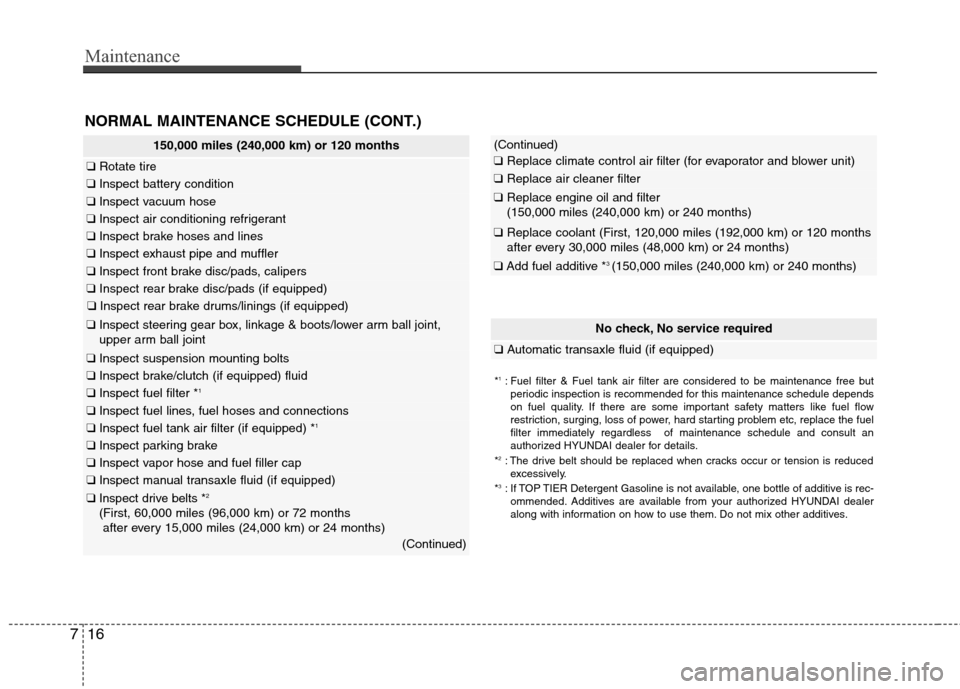
Maintenance
16 7
150,000 miles (240,000 km) or 120 months
ŌØæRotate tire
ŌØæInspect battery condition
ŌØæInspect vacuum hose
ŌØæInspect air conditioning refrigerant
ŌØæInspect brake hoses and lines
ŌØæInspect exhaust pipe and muffler
ŌØæInspect front brake disc/pads, calipers
ŌØæInspect rear brake disc/pads (if equipped)
ŌØæInspect rear brake drums/linings (if equipped)
ŌØæInspect steering gear box, linkage & boots/lower arm ball joint,
upper arm ball joint
ŌØæInspect suspension mounting bolts
ŌØæInspect brake/clutch (if equipped) fluid
ŌØæInspect fuel filter *1
ŌØæInspect fuel lines, fuel hoses and connections
ŌØæInspect fuel tank air filter (if equipped) *1
ŌØæInspect parking brake
ŌØæInspect vapor hose and fuel filler cap
ŌØæInspect manual transaxle fluid (if equipped)
ŌØæInspect drive belts *2
(First, 60,000 miles (96,000 km) or 72 months
after every 15,000 miles (24,000 km) or 24 months)
(Continued)
NORMAL MAINTENANCE SCHEDULE (CONT.)
No check, No service required
ŌØæAutomatic transaxle fluid (if equipped)
*1: Fuel filter & Fuel tank air filter are considered to be maintenance free but
periodic inspection is recommended for this maintenance schedule depends
on fuel quality. If there are some important safety matters like fuel flow
restriction, surging, loss of power, hard starting problem etc, replace the fuel
filter immediately regardless of maintenance schedule and consult an
authorized HYUNDAI dealer for details.
*
2: The drive belt should be replaced when cracks occur or tension is reduced
excessively.
*
3: If TOP TIER Detergent Gasoline is not available, one bottle of additive is rec-
ommended. Additives are available from your authorized HYUNDAI dealer
along with information on how to use them. Do not mix other additives.
(Continued)
ŌØæReplace climate control air filter (for evaporator and blower unit)
ŌØæReplace air cleaner filter
ŌØæReplace engine oil and filter
(150,000 miles (240,000 km) or 240 months)
ŌØæReplace coolant (First, 120,000 miles (192,000 km) or 120 months
after every 30,000 miles (48,000 km) or 24 months)
ŌØæAdd fuel additive *3 (150,000 miles (240,000 km) or 240 months)